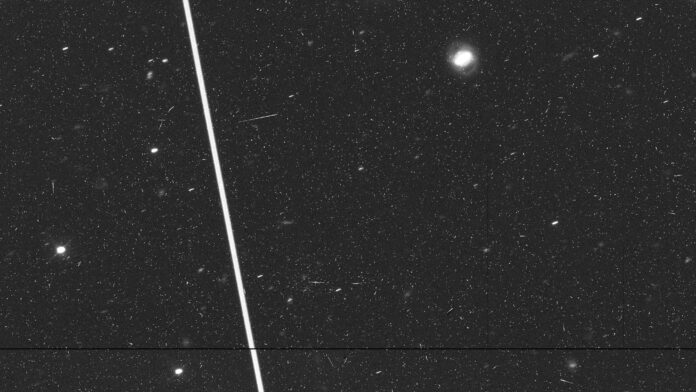Astronomers have already been raising alarm bells about satellites, including those from Starlink, photo-bombing telescope observations from Earth. But now a new study warns the same satellites risk one day disrupting images taken by the Hubble Space Telescope.
As The New York Times reports(Opens in a new window), a group of researchers published a paper(Opens in a new window) on Thursday, examining the percentage of archived Hubble Space observations that contain satellite streaks running through the images.
The good news is that only 2.7% of the images contained satellite streaks, making the problem relatively minor. However, the researchers say the satellite streaks grew over time. From 2018 to 2021, the satellite photo-bombing reached 4.3% of the observations for Hubble’s ACS camera system(Opens in a new window), which is up from 2.8% during the 2002 to 2005 time span.
Examples of satellite trails found in Hubble Space Telescope observations.
(Credit: Sandor Kruk/HST)
It’s possible SpaceX’s Starlink is partly responsible for the uptick. Starting in 2019, the company began launching dozens of satellites to build out the orbital internet system.
The study notes Starlink satellites travel about a dozen kilometers or more above the Hubble Space Telescope, which orbits Earth at 535 kilometers. The relatively close proximity means Starlink “will appear less frequently in the images since there will be fewer visible to HST, but they will produce broader trails,” the researchers wrote.
A Hubble observation taken from 2021 with a prominent satellite streak.
(Credit: Sandor Kruk/HST)
“Assuming that an artificial satellite will pass at only 100 km from the pointing of HST, the 3 m Starlink satellite will produce a wide band of 6″ or 120 pixels across the ACS detector, which might have an impact on the scientific exploitation of the HST data,” they added.
However, SpaceX is pushing back on worries its satellites will interfere with the Hubble Space Telescope. In an email, it pointed to a statement NASA gave to the Times about the study.
“While such analyses may show a gradual increase in detected satellite trails over time, most of these streaks are readily removed using standard data reduction techniques, and the majority of affected images are still usable,” the NASA spokesperson said. “Satellite streaks do not currently pose a significant threat to Hubble’s science efficiency and data analysis.”
SpaceX has also been working with the astronomy community to prevent Starlink satellites from reflecting light. This includes signing an agreement with the US National Science Foundation pledging cooperation on the matter.
Recommended by Our Editors
As for the study, it had a key limitation: the researchers only examined Hubble images taken from 2002 to 2021, when SpaceX only had 1,562 satellites in orbit. Since then, the number of Starlink satellites has doubled to nearly 4,000 satellites. (SpaceX has also secured an FCC license to launch another 7,500 satellites to create a second-generation Starlink network.)
The study also notes “no scientific impact of satellite trails on HST data has been reported so far.” That said, the researchers estimate the chances of Hubble encountering a satellite streak could reach between 20% to 50% if the number of satellites in Earth’s orbit skyrockets from 60,000 to 100,000, given that numerous parties, including Amazon and China, are also planning their own satellite mega constellations.
(Credit: Sandor Kruk)
“With the growing number of artificial satellites currently planned, the fraction of Hubble Space Telescope images crossed by satellites will increase in the next decade and will need further close study and monitoring,” the researchers added.
Get Our Best Stories!
Sign up for What’s New Now to get our top stories delivered to your inbox every morning.
This newsletter may contain advertising, deals, or affiliate links. Subscribing to a newsletter indicates your consent to our Terms of Use and Privacy Policy. You may unsubscribe from the newsletters at any time.
Hits: 0


















